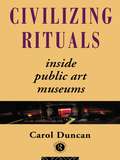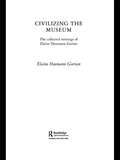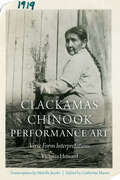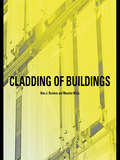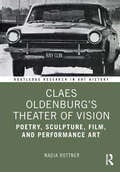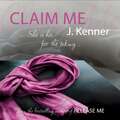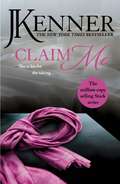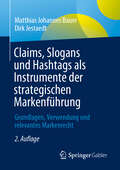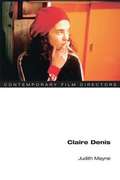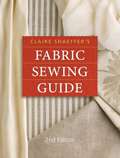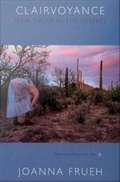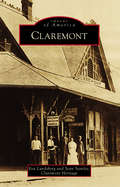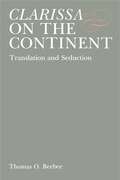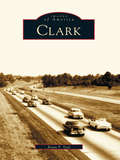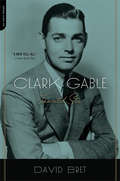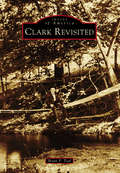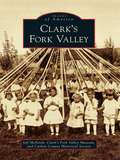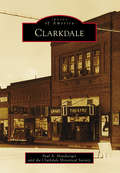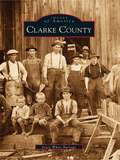- Table View
- List View
Civilizing Rituals: Inside Public Art Museums (Re Visions Ser.)
by Carol DuncanIllustrated with over fifty photos, Civilizing Rituals merges contemporary debates with lively discussion and explores central issues involved in the making and displaying of art as industry and how it is presented to the community. Carol Duncan looks at how nations, institutions and private individuals present art , and how art museums are shaped by cultural, social and political determinants. Civilizing Rituals is ideal reading for students of art history and museum studies, and professionals in the field will also find much of interest here.
Civilizing the Museum: The Collected Writings of Elaine Heumann Gurian
by Elaine Heumann GurianWritten over a thirty-five year career, the essays in Civilizing the Museum introduce students to the powerful, sometimes contested, and often unrealized notion that museums should welcome all because they house the collective memory of all. Drawing on her experience working in and with museums in the US and throughout the world, Author Elaine Heumann Gurian explores the possibilities for making museums more central and relevant to society. The twenty-two essays are organized around five main themes: * museum definitions* civic responsibility and social service* architectural spaces* exhibitions* spirituality and rationality. And these themes address the elements that would make museums more inclusive such as: * exhibition technique* space configurations* the personality of the director* the role of social service* power sharing* types of museums* the need for emotion humour and spirituality. Without abandoning the traditional museum processes, Gurian shows how museums can honour tradition whilst embracing the new. Enriched by her experience in groundbreaking museums, Gurian has provided a book that provokes thought, dialogue and action for students and professionals in the field to realize the inclusive potential of museums.
Clackamas Chinook Performance Art: Verse Form Interpretations (Studies in the Anthropology of North American Indians)
by Victoria HowardPublished through the Recovering Languages and Literacies of the Americas initiative, supported by the Andrew W. Mellon FoundationVictoria Howard was born around 1865, a little more than ten years after the founding of the Confederated Tribes of Grand Ronde in western Oregon. Howardʼs maternal grandmother, Wagayuhlen Quiaquaty, was a successful and valued Clackamas shaman at Grand Ronde, and her maternal grandfather, Quiaquaty, was an elite Molalla chief. In the summer of 1929 the linguist Melville Jacobs, student of Franz Boas, requested to record Clackamas Chinook oral traditions with Howard, which she enthusiastically agreed to do. The result is an intricate and lively corpus of linguistic and ethnographic material, as well as rich performances of Clackamas literary heritage, as dictated by Howard and meticulously transcribed by Jacobs in his field notebooks. Ethnographical descriptions attest to the traditional lifestyle and environment in which Howard grew up, while fine details of cultural and historical events reveal the great consideration and devotion with which she recalled her past and that of her people.Catharine Mason has edited twenty-five of Howard&’s spoken-word performances into verse form entextualizations, along with the annotations provided by Jacobs in his publications of Howard&’s corpus in the late 1950s. Mason pairs performances with biographical, family, and historical content that reflects Howardʼs ancestry, personal and social life, education, and worldview. Mason&’s study reveals strong evidence of how the artist contemplated and internalized the complex meanings and everyday lessons of her literary heritage.
Cladding of Buildings
by Alan J. Brookes Maarten MeijsThis key text addresses the topic of lightweight claddings in buildings and is a useful guide and reference resource. Written by well-known specialists in the field, this fourth edition of an established text has been revised throughout to incorporate the latest environmental issues, the use of wood and terracotta in cladding, and use of new materials, particularly the new moulded materials. Two new chapters cover wood and terracotta in cladding. The main types of cladding systems are described in detail and methods of production, performance characteristics, applications and methods of assembly are explained clearly. Illustrated throughout with photographs and numerous line drawings, this is an essential overview of the subject for both the student and the practising architect.
Claes Oldenburg's Theater of Vision: Poetry, Sculpture, Film, and Performance Art (Routledge Research in Art History)
by Nadja RottnerIn four chronologically organized chapters, this study traces the conceptual dependence and deep connectivity among Claes Oldenburg’s poetry, sculpture, films, and performance art between 1956 and 1965. This research-intensive book argues that Oldenburg’s art relies on machine vision and other metaphors to visualize the structure and image content of human thought as an artistic problem. Anchored in new oral history interviews and extensive archival material, it brings together understudied visual and concrete poetry, experimental films, fifteen group performances (commonly referred to as happenings), and a close analysis of his well-known installations of The Street (1960) and The Store (1961–62), effectively setting in place a reexamination of Oldenburg’s pop art from the street, store, home, and cinema years. The book will be of interest to scholars working in art history, film studies, performance studies, literature, intermedia studies, and media theory.
Claes Oldenburg's Theater of Vision: Poetry, Sculpture, Film, and Performance Art (Routledge Research in Art History)
by Nadja RottnerIn four chronologically organized chapters, this study traces the conceptual dependence and deep connectivity among Claes Oldenburg’s poetry, sculpture, films, and performance art between 1956 and 1965.This research-intensive book argues that Oldenburg’s art relies on machine vision and other metaphors to visualize the structure and image content of human thought as an artistic problem. Anchored in new oral history interviews and extensive archival material, it brings together understudied visual and concrete poetry, experimental films, fifteen group performances (commonly referred to as happenings), and a close analysis of his well-known installations of The Street (1960) and The Store (1961–62), effectively setting in place a reexamination of Oldenburg’s pop art from the street, store, home, and cinema years.The book will be of interest to scholars working in art history, film studies, performance studies, literature, intermedia studies, and media theory.
Claim Me: Book 2: Stark Trilogy (Stark Series #4)
by J. KennerFor fans of Fifty Shades of Grey and the Crossfire series. In Release Me, powerful multimillionaire Damien Stark made Southern belle Nikki Fairchild an unforgettable indecent proposal which she couldn't resist. Now their sensual, erotic, powerfully emotional romance continues in Claim Me, the next in J. Kenner's New York Times bestselling series.For Damien, our obsession is a game. For me, it is fiercely, blindingly, real.Damien Stark's need is palpable - his need for pleasure, his need for control, his need for me. Beautiful and brilliant yet tortured at his core, he is in every way my match. I have agreed to be his alone, and now I want him to be fully mine. I want us to possess each other beyond the sweetest edge of our ecstasy, into the deepest desires of our souls. To let the fire that burns between us consume us both. But there are dark places within Damien that not even our wildest passion can touch. I yearn to know his secrets, yearn for him to surrender to me as I have surrendered to him. But our troubled pasts will either bind us close...or shatter us completely.Spellbinding romance. Electrifying passion. Why not indulge in J. Kenner...Discover the whole story of Damien and Nikki's epic romance in J. Kenner's hot and addictive bestselling Stark series: Release Me, Claim Me, Complete Me, Take Me, Have Me, Play My Game, Seduce Me, Unwrap Me, Deepest Kiss, Entice Me and Anchor Me.(P)2013 Headline Digital
Claim Me: The Stark Series #2 (Stark Series #4)
by J. KennerFor fans of Fifty Shades of Grey and the Crossfire series. In Release Me, powerful multimillionaire Damien Stark made Southern belle Nikki Fairchild an unforgettable indecent proposal which she couldn't resist. Now their sensual, erotic, powerfully emotional romance continues in Claim Me, the next in J. Kenner's New York Times bestselling series.For Damien, our obsession is a game. For me, it is fiercely, blindingly, real.Damien Stark's need is palpable - his need for pleasure, his need for control, his need for me. Beautiful and brilliant yet tortured at his core, he is in every way my match. I have agreed to be his alone, and now I want him to be fully mine. I want us to possess each other beyond the sweetest edge of our ecstasy, into the deepest desires of our souls. To let the fire that burns between us consume us both. But there are dark places within Damien that not even our wildest passion can touch. I yearn to know his secrets, yearn for him to surrender to me as I have surrendered to him. But our troubled pasts will either bind us close...or shatter us completely.Spellbinding romance. Electrifying passion. Why not indulge in J. Kenner...Discover the whole story of Damien and Nikki's epic romance in J. Kenner's hot and addictive bestselling Stark series: Release Me, Claim Me, Complete Me, Take Me, Have Me, Play My Game, Seduce Me, Unwrap Me, Deepest Kiss, Entice Me and Anchor Me.
Claims, Slogans und Hashtags als Instrumente der strategischen Markenführung: Grundlagen, Verwendung und relevantes Markenrecht
by Matthias Johannes Bauer Dirk JestaedtDie Autoren zeigen, wie ein passender und zudem origineller und einzigartiger Claim erschaffen werden kann. Dabei erläutern sie, wie pauschale Wortzusammenstellungen vermieden werden, wie die Qualität des Claims methodisch und systematisch überprüft werden kann und welche markenrechtlichen Aspekte zu berücksichtigen sind. Das Buch richtet sich an Marketing- und Kommunikationsverantwortliche, aber auch an Studierende und Dozierende mit dem Schwerpunkt Marketing oder Unternehmenskommunikation. Die 2. Auflage wurde überarbeitet und erweitert und um den Themenbereich der Hashtags ergänzt.
Claire Denis (Contemporary Film Directors)
by Judith MayneWidely regarded as one of the most innovative and passionate filmmakers working in France today, Claire Denis has continued to make beautiful and challenging films since the 1988 release of her first feature, Chocolat. Judith Mayne's comprehensive study of these films traces Denis's career and discusses her major feature films in rich detail. Born in Paris but having grown up in Africa, Denis explores in her films the legacies of French colonialism and the complex relationships between sexuality, gender, and race. From the adult woman who observes her past as a child in Cameroon to the Lithuanian immigrant who arrives in Paris and watches a serial killer to the disgraced French Foreign Legionnaire attempting to make sense of his past, the subjects of Denis's films continually revisit themes of watching, bearing witness, and making contact, as well as displacement, masculinity, and the migratory subject.
Claire Shaeffer's Fabric Sewing Guide
by Claire ShaefferClaire Shaeffer's Fabric Sewing Guide is your one-stop sewing resource, with answers to the most common sewing questions and details about the latest advancements in sewing. This new, thoroughly updated edition contains everything you need to know, and will surely be a reference you will review again and again. In addition to an extensive glossary with answers to the most common sewing questions, this must-have guide includes easy-to-read charts for needle sizes and thread and stabilizer types. It also includes 225 full-color photos and a fabric and fiber dictionary. Truly a one-stop reference when looking for answers.
Claire Shaeffer's Fabric Sewing Guide
by Claire ShaefferClaire Shaeffer's Fabric Sewing Guide is your one-stop sewing resource, with answers to the most common sewing questions and details about the latest advancements in sewing. This new, thoroughly updated edition contains everything you need to know, and will surely be a reference you will review again and again. In addition to an extensive glossary with answers to the most common sewing questions, this must-have guide includes easy-to-read charts for needle sizes and thread and stabilizer types. It also includes 225 full-color photos and a fabric and fiber dictionary. Truly a one-stop reference when looking for answers.
Clairvoyance (For Those In The Desert): Performance Pieces, 1979–2004
by Joanna FruehThe performance artist Joanna Frueh has emerged over the past twenty-five years as a wildly original voice in feminist art. Her uninhibited performances are celebrations of beauty, sensuality, eroticism, and pleasure. Clairvoyance (For Those In The Desert), which features eighteen of her essential performance texts, is a celebration of this remarkable artist and her work. Arranged chronologically, from The Concupiscent Critic (1979) through Ambrosia (2004), the pieces reveal Frueh's evolution as an artist and intellectual over the course of her career. Many of these texts have never before been published; others have not been readily available until now. Among the sixteen color photographs in this richly illustrated book are pictures of Frueh performing and images from Joanna in the Desert, a 2006 collaboration between Frueh and the artist and scholar Jill O'Bryan.Frueh's performances are unabashedly autobiographical, as likely to reflect her scholarship as a feminist art historian as her love affairs or childhood memories. For Frueh, eros and self-love are part of a revolutionary feminist strategy; her work exemplifies the physicality and embrace of pleasure that she finds wanting in contemporary feminist theory. Scholarly and rigorous yet playful in tone, her performances are joyful, filled with eroticism, flowers, sexy costumes, and beautiful colors, textures, and scents. Recurring themes include Frueh's passionate attachment to the desert landscape and the idea of transformation: a continual reaching for clarity of thought and feeling.In an afterword as lyrical and breathless as her performance pieces, Frueh explores her identification with the desert and its influence on her art. Clairvoyance (For Those In The Desert) includes a detailed chronology of Frueh's performances.
Claremont
by Eva Landsberg Claremont Heritage Sean StanleySituated along the eastern border of Los Angeles County and at the foot of the majestic San Gabriel Mountains is the community of Claremont. The city, founded in 1887 and incorporated in 1907, quickly became one of Southern California's most unique communities. Known as the "City of Trees and PhDs," Claremont has become famous for its lush oak-and-sycamore-lined boulevards, beautifully crafted architecture, and as the home of the highly praised liberal arts schools of the Claremont Colleges. First settled by the Serrano peoples on Indian Hill Mesa and once part of the vast Rancho San Jose, Claremont has gone through several important periods, including expanding from a frontier town to a Congregationalist hub and transitioning from a citrus powerhouse to an artist colony. Equal parts suburban community and college town, Claremont has attracted many for its picturesque setting and charming small-town feel.
Clarice Cliff
by Will FarmerThere are few pieces of pottery more recognizable than those designed by Clarice Cliff. For many the epitome of Art Deco, and 1930s style, characterised by bold color and lines, geometric shapes, and stylized representations of the countryside, Clarice Cliff's 'Bizarre' pottery is widely collected all over the world.This book traces the story of Clarice Cliff and the pottery that she created. Born in 1899 and employed in The Potteries from the age of 13, Clarice was talented, ambitious and resourceful, and in 1927 she was given her own studio at the Newport Pottery, and for the next twelve years she produced a range of designs that were loved by countless ordinary thirties household, and have become icons of the age. Clarice Cliff expert Will Farmer examines each of Clarice's important styles and designs, with the help of a wealth of high quality color illustrations. This is the perfect introduction to this most popular of all British pottery.From the Trade Paperback edition.
Clarissa on the Continent: Translation and Seduction (G - Reference, Information and Interdisciplinary Subjects)
by Thomas O. Beebee"Clarissa" on the Continent defines and explores two strategies of literary translation—creative vs. preservative and strong vs. weak—as they transform one of the most influential English novels. Thomas Beebee compares the two opposing strategies as they influence the French translation of Clarissa by the novelist Antione François de Prévost and the German translation by the Göttingen Orientalist Johann David Michaelis, and in doing so he demonstrates that each translator found authority for his procedure within the text itself. Each translation is also examined in light of Richardson's other writings and placed in its literary and cultural context. This study uses translations in order to interpret Clarissa, to show how the basis for the novel's reception on the Continent was laid, and to explore the differences and interactions among three literary and cultural systems of the eighteenth century. The close examination of these two important translations enable the formulation of not only a theory of creative vs. preservative translation but also the interconnections between literary theory and translation theory. Beebee also looks at later translations of Clarissa as products of literary and historical change and at Prévostian strategies of the novel.
Clark (Images of America)
by Brian P. ToalClark explores a community with a history dating from 1864, the height of the Civil War. Accessed by Exit 135 on the Garden State Parkway, Clark was originally the Fifth Ward of Rahway until a group of disgruntled farmers, led by founding fathers Robert A. Russell, William Bloodgood, William H. Enders, Smith Woodruff, and Judge Hugh H. Bowne, declared its independence and established a self-governing township. The men named the town for a local American patriot and signer of the Declaration of Independence, Abraham Clark. The vintage photographs included here represent Clark's history from its days as a rural farm town of the nineteenth and early twentieth centuries to its current status as a thriving suburban community.
Clark County
by Greg FurnessClark County was created in 1873 by an act of territorial legislature. It was named for Newton Clark, a territorial legislator. On June 27, 1878, the first white settlers arrived in Clark County. Settlers continued migrating to Clark County, and by 1880, there were enough settlers to petition for organization. On May 23, 1881, Clark County became an official county. The first courthouse was built in 1888 in Clark. Besides Clark, the following towns were soon formed: Bradley, Carpenter, Crocker, Elrod, Garden City, Melham, Naples, Raymond, Vienna, and Willow Lake. Clark County, located in northeast South Dakota in the Glacial Lakes and Prairie Region, is home to some 4,500 residents.
Clark Gable: A Biography
by Warren G. HarrisClark Gable arrived in Hollywood after a rough-and-tumble youth, and his breezy, big-boned, everyman persona quickly made him the town's king. He was a gambler among gamblers, a heavy drinker in the days when everyone drank seemingly all the time, and a lover to legions of the most attractive women in the most glamorous business in the world, including the great love of his life, Carole Lombard.In this well-researched and revealing biography, Warren G. Harris gives an exceptionally acute portrait of one of the most memorable actors in the history of motion pictures--whose intimates included such legends as Marilyn Monroe, Joan Crawford, Loretta Young, David O. Selznick, Jean Harlow, Judy Garland, Lana Turner, Spencer Tracy, and Grace Kelly--as well as a vivid sense of the glamour and excess of mid-century Hollywood.From the Trade Paperback edition.
Clark Gable: Tormented Star
by David BretFrom the acclaimed author of Joan Crawford comes a riveting and uncensored biography of Clark Gable. The archetypal male of his era, Gable was named "King of Hollywood" in 1938. But as David Bret reveals, the star was not quite who he seemed.<P><P> One of Gable's best-kept secrets was his bisexuality. Bret recounts Gable's failed marriages to women who turned a blind eye toward his affairs with actors Earl Larimore and Rod La Rocque, among other men. Bret also reveals how a pseudo-scandalous paternity suit and the actor's wartime accomplishments were no more than elaborate publicity stunts created by studio chief Louis B. Mayer in order to exaggerate Gable's masculinity and heroism in the public eye. With passion and accuracy, Bret uncovers the truth behind one of Hollywood's biggest stars.
Clark Revisited
by Brian P. ToalClark Revisited takes a second look at the past of a community whose humble beginnings can be traced back to the height of the Civil War. Located in Central New Jersey, the township of Clark began as a quiet agricultural community. But with the 20th century came many changes, and the development of the Garden State Parkway became a catalyst for Clark's transition into a community with housing developments, businesses, and a renewed image. These changes can be largely attributed to land developers, as well as the leadership of mayors who have served Clark over the last half of the century. New Jersey Monthly magazine has credited Clark as one of the best places to live in New Jersey. What was once rural farmland has grown into a thriving, suburban community that continues to develop both socially and economically.
Clark's Fork Valley (Images of America)
by Jeff Mcneish Carbon County Historical Society Clark’s Fork Valley MuseumMany of the great icons of western American history left their mark on Carbon County while living in or traveling through the natural byway that is Montana's Clark's Fork Valley. The Apsáalooke, or Crow, people called the valley home for centuries. The Lewis and Clark expedition recorded and named the valley's river in 1806. In 1807-1808, John Colter, the discoverer of Yellowstone Park, explored the southern end of the valley. The Rocky Mountain Fur Company and adventurers like Jedediah Smith, Joe Meek, and Thomas Fitzpatrick soon followed. In 1864, Jim Bridger blazed the Bridger Trail through the valley. Chief Joseph and his band of Nez Perce followed the valley north from Yellowstone Park during their 1877 flight toward Canada. Calamity Jane and Caroline Lockhart, a noted author and literary rival of Zane Grey, once called the valley home, and Buffalo Bill Cody and John "Liver-Eating" Johnston visited it frequently.
Clarkdale
by Clarkdale Historical Society Paul A. HandvergerClarkdale is recognized as a "Place of History" in the National Register of Historic Places, possessing both historical and architectural significance. Clarkdale's story began eons ago with the creation of its natural environment. The first people came thousands of years ago to this lush land, followed by subsequent cultures that made use of the abundant water, rich soil, and moderate climate. In the early 20th century, mining magnate William Clark built the smelter company town of Clarkdale; the agricultural age was soon replaced by the industrial age. Clark became one of the wealthiest men in America, with most of his money coming from the output of Clarkdale's smelter. Since the smelter closure in 1953, the former workers' homes, smelter site, and company lands have been recycled into today's homes, a tourist destination, and a place of museums, education, and the arts, all located within a spectacular environment of mountains and river. This book presents that story.
Clarke County
by Joyce White BurrageClarke County is a beautifully wooded and peaceful spot in west Alabama with a long and rich history.Bounded on the east by the Alabama River and on thewest by the Tombigbee River, Clarke County's richtimberlands serve as the source for pine timber markets throughout the world. The fantastic hunting and fishing in the county are known throughout the South. Clarke County's history includes the story of the Mitcham War, a period of unrest in 1893 that reached state-wide proportions in notoriety. The county's history is one largely comprised of the working men and women who have contributed to the cultural tapestry of the area. This visual journey begins around the time of the earliest woodcut of the courthouse in Grove Hill, built in 1832, and continues through the 1940s. Many of the images in this collection have never before been published. These fascinating glimpses into Clarke County's past are combined with a well-researched text to uncover many long-forgotten stories and a colorful cast of characters.
Clarksdale and Coahoma County (Images of America)
by Carnegie Public Library Judith Coleman FlowersSettlers came to Clarksdale and Coahoma County with dreams of owning land and building a future. Some bought small plots to build a cabin and carve out a living, while others amassed large acreages of the most fertile soil in the world. They found nearly impenetrable forests and cane breaks and were confronted with unbearable hardships as they attempted to tame the land. With perseverance and the labor of African Americans using oxen, mules, and crude tools, Coahoma County made Clarksdale the "Golden Buckle on the Cotton Belt." From this labor a phenomenon has enveloped the city, and the preservation of the heritage and traditions of Delta blues has made Clarksdale an international destination for those searching for the authentic roots of blues music.
